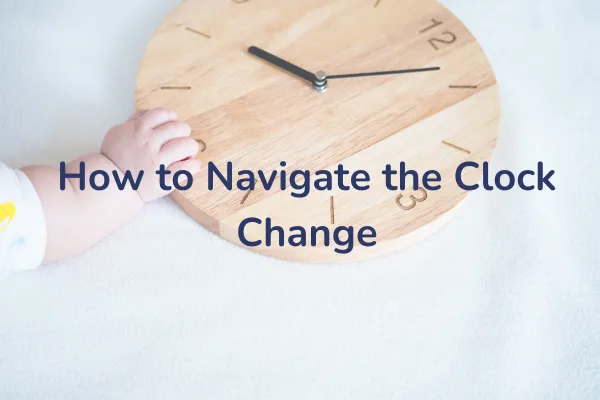
Autumn clock change
How to Help Your Child Adjust to the Autumn Clock Change: Three Proven Methods Explained
Twice a year, parents across the UK brace themselves for the clock change. The autumn shift—when we “fall back” an hour—can bring welcome daylight in the mornings, but it also disrupts sleep patterns, especially for young children. If you’ve ever found yourself facing a child who’s suddenly waking at 5am (or earlier!), you know how challenging this transition can be and for this reason it is known in the sleep industry as 'the tricky one'.
As a certified Sleep Nanny® and early childhood expert, I’ve helped hundreds of families navigate the clock change without drama or overtiredness. The key? Choosing the adjustment method that fits your child’s age, temperament, and your family’s lifestyle.
Let’s break down the three most effective ways to handle the autumn clock change, and how to decide which is right for you.
Why the Autumn Clock Change Matters
When the clocks go back, your child’s internal body clock doesn’t instantly reset. If bedtime was 7:00pm, suddenly it feels like 6:00pm to them. The result? Early rising, overtired evenings, and a disrupted routine for everyone.
The good news: with a little planning, you can help your child adjust smoothly—and even use the opportunity to reinforce healthy sleep habits.
Method 1: The Gradual Approach (15 Minutes Each Day)
How it works:
Starting on the Wednesday before the clock change ideally, move your child’s bedtime 15 minutes later each night. By the time Sunday arrives, bedtime will be a full hour later—matching the new time after the clocks go back.
Example schedule:
Wednesday: Bedtime 7:15pm
Thursday: Bedtime 7:30pm
Friday: Bedtime 7:45pm
Saturday: Bedtime 8:00pm
Sunday: Bedtime 7:00pm (new time)
Who is it for?
This method is ideal for babies, toddlers, and children who are sensitive to routine changes. If your child struggles with overtiredness or takes a while to adjust to new schedules, the gradual approach is gentle and effective.
Pro tip:
Adjust naps and mealtimes by 15 minutes as well to keep everything in sync.
Method 2: The 50/50 Split
How it works:
Move bedtime 30 minutes later on Saturday night (old time). After the clocks change, put your child to bed at their usual time on Sunday (now the new time).
Example schedule:
Friday: Bedtime 7:00pm
Saturday: Bedtime 7:30pm (old time)
Sunday: Bedtime 7:00pm (new time)
Who is it for?
This approach suits pre-schoolers and children who can handle a moderate shift. It’s a good balance for families who want to make the transition quickly but still avoid the shock of a full hour’s change in one night.
Pro tip:
Keep the bedtime routine calm and predictable—this helps signal to your child’s body that it’s time to wind down, even with the time change.
Method 3: The All-In-One
How it works:
Keep bedtime the same all week, then switch straight to the new time on Sunday night after the clocks change. No gradual adjustments—just a single jump.
Example schedule:
Friday: Bedtime 7:00pm
Saturday: Bedtime 7:00pm
Sunday: Bedtime 7:00pm (new time)
Who is it for?
This method works well for older children, easy-going sleepers, or families who prefer to keep things simple. If your child adapts easily to change, you may find this approach is all you need.
Pro tip:
Expect some early mornings for a few days, but most children will adjust within a week.
Which Method Should You Choose?
There’s no one-size-fits-all answer. Here’s how to decide:
Babies and toddlers often do best with the gradual 15-minute method. Their body clocks are more sensitive, and small changes help avoid overtiredness.
Pre-schoolers and flexible children may thrive with the 50/50 split.
Older children or easy adapters can usually handle the all-in-one approach without issue.
Consider your child’s temperament, sleep history, and how they’ve handled changes before. If you’re unsure, start with the gradual method—it’s the gentlest and least likely to cause sleep disruptions.
How to Handle Early Rising After the Clock Change
Even with the best planning, some children will wake early for a few days after the clocks go back. This is completely normal. The trick is to stay consistent with your chosen bedtime, keep the room dark in the mornings, and avoid starting the day too early. If your child is waking before 6am, treat it as a night waking: keep lights low, voices quiet, and encourage them to rest until it’s time to get up.
Want more strategies for tackling early mornings? I’ve created a free Early Rising Guide packed with practical tips and gentle solutions. To receive your copy, click here and I’ll send it straight to your inbox.
The Autumn Clock Change Doesn’t Have to Mean Lost Sleep
With a little preparation and the right approach for your family, you can navigate the clock change with confidence. Remember: consistency, patience, and a gentle routine are your best tools. And if you need extra support, my Early Rising Guide is here to help.
Wishing you peaceful nights and brighter mornings this autumn!